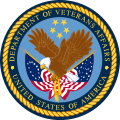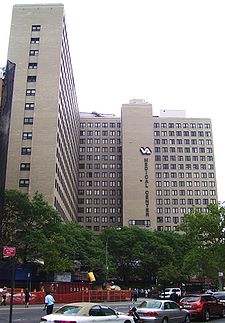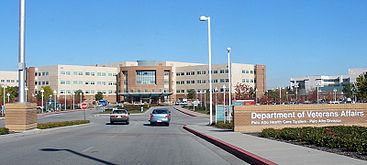- United States Department of Veterans Affairs
-
United States
Department of Veterans Affairs
Seal of the Department of Veterans Affairs 
VA Logo Agency overview Formed July 21, 1930
(Cabinet rank 15 March 1989)Preceding agency Veterans Administration Jurisdiction Federal government of the United States Headquarters 810 Vermont Avenue NW., Washington, D.C., United States
38°54′3.250″N 77°2′5.366″W / 38.9009028°N 77.03482389°WEmployees 278,565 (2008) Annual budget $87.6 billion (2009) Agency executives Eric Shinseki, General USA, Ret., Secretary
W. Scott Gould,
Deputy SecretaryChild agency Click Here Website va.gov The United States Department of Veterans Affairs (VA) is a government-run military veteran benefit system with Cabinet-level status. It is the United States government’s second largest department, after the United States Department of Defense. With a total 2009 budget of about $87.6 billion, VA employs nearly 280,000 people at hundreds of Veterans Affairs medical facilities, clinics, and benefits offices and is responsible for administering programs of veterans’ benefits for veterans, their families, and survivors.
The benefits provided include disability compensation, pension, education, home loans, life insurance, vocational rehabilitation, survivors’ benefits, medical benefits and burial benefits.[1] It is administered by the United States Secretary of Veterans Affairs.
Contents
History
The Continental Congress of 1776 encouraged enlistments during the American Revolutionary War by providing pensions for soldiers who were disabled. Direct medical and hospital care given to veterans in the early days of the republic was provided by the individual states and communities. In 1811, the first domiciliary and medical facility for veterans was authorized by the federal government, but not opened until 1834. In the 19th century, the nation's veterans assistance program was expanded to include benefits and pensions not only for veterans, but also their widows and dependents.
After the Civil War, many state veterans homes were established. Since domiciliary care was available at all state veterans homes, incidental medical and hospital treatment was provided for all injuries and diseases, whether or not of service origin. Indigent and disabled veterans of the Civil War, Indian Wars, Spanish-American War, and Mexican Border period as well as discharged regular members of the Armed Forces were cared for at these homes.
Congress established a new system of veterans benefits when the United States entered World War I in 1917. Included were programs for disability compensation, insurance for servicepersons and veterans, and vocational rehabilitation for the disabled. By the 1920s, the various benefits were administered by three different federal agencies: the Veterans Bureau, the Bureau of Pensions of the Interior Department, and the National Home for Disabled Volunteer Soldiers.
The establishment of the Veterans Administration came in 1930 when Congress authorized the president to "consolidate and coordinate Government activities affecting war veterans." The three component agencies became bureaus within the Veterans Administration. Brigadier General Frank T. Hines, who directed the Veterans Bureau for seven years, was named as the first Administrator of Veterans Affairs, a job he held until 1945.
The VA health care system has grown from 54 hospitals in 1930 to include 171 medical centers; more than 350 outpatient, community, and outreach clinics; 126 nursing home care units; and 35 domiciliaries. VA health care facilities provide a broad spectrum of medical, surgical, and rehabilitative care. The responsibilities and benefits programs of the Veterans Administration grew enormously during the following six decades. World War II resulted in not only a vast increase in the veteran population, but also in large number of new benefits enacted by Congress for veterans of the war. The World War II GI Bill, signed into law on June 22, 1944, is said to have had more impact on the American way of life than any law since the Homestead Act more than a century ago. Further educational assistance acts were passed for the benefit of veterans of the Korean War, the Vietnam Era, the introduction of the "All-Volunteer Force" in the 1970s (following the end of conscription in the United States in 1973), the Persian Gulf War, and those who served following the attacks of September 11, 2001.
In 1973, the Veterans Administration assumed another major responsibility when the National Cemetery System (NCS) (except for Arlington National Cemetery) was transferred to the Veterans Administration from the Department of the Army. The VA was charged with the operation of the NCS, including the marking of graves of all persons in national and State cemeteries (and the graves of veterans in private cemeteries, upon request) as well and administering the State Cemetery Grants Program.
The Department of Veterans Affairs (VA) was established as a Cabinet-level position on March 15, 1989. President George H.W. Bush hailed the creation of the new department saying, "There is only one place for the veterans of America, in the Cabinet Room, at the table with the President of the United States of America."
Organization and function
The Department of Veterans Affairs is headed by the Secretary of Veterans Affairs, appointed by the President with the advice and consent of the Senate. The current Secretary of Veterans Affairs is Ret. General Eric Shinseki. The primary function of the Department of Veterans Affairs is to support Veterans in their time after service by providing certain benefits and supports. A current initiative in the Department of Veterans Affairs is to prevent and end Veterans' homelessness [2], with the VA working with the United States Interagency Council on Homelessness to address these issues. General Shinseki sits on the Council, and is commmitted to the goal of ending Veterans homelessness by 2015 as laid out in Opening Doors: Federal Strategic Plan to Prevent and End Homelessness, which was released in 2010. [3]
The Department has three main subdivisions, known as Administrations, each headed by an Undersecretary:
- Veterans Health Administration - responsible for providing health care in all its forms, as well as for medical research, Community Based Outpatient Clinics (CBOCs), and Regional Medical Centers
- Veterans Benefits Administration - responsible for initial veteran registration, eligibility determination, and five key lines of business (benefits and entitlements): Home Loan Guaranty, Insurance, Vocational Rehabilitation and Employment, Education (GI Bill), and Compensation & Pension
- National Cemetery Administration - responsible for providing burial and memorial benefits, as well as for maintenance of VA cemeteries
Costs for care
As is common in any time of war, recently there has been an increased demand for nursing home beds, injury rehabilitation, and mental health care. VA categorizes veterans into eight priority groups and several additional subgroups, based on factors such as service-connected disabilities, and one’s income and assets (adjusted to local cost of living).
Veterans with a 50% or higher service-connected disability as determined by a VA regional office “rating board” (e.g., losing a limb in battle, PTSD, etc.) are provided comprehensive care and medication at no charge. Veterans with lesser qualifying factors who exceed a pre-defined income threshold have to make co-payments for care for non-service-connected ailments and pay $9 per 30-day supply for each prescription medication. VA dental and nursing home care benefits are more restricted.
Reservists and National Guard personnel who served stateside in peacetime settings or have no service-related disabilities generally do not qualify for VA health benefits.[4] In recent years, the VA has opened hundreds of new convenient outpatient clinics in towns across the United States, while steadily reducing inpatient bed levels at its hospitals.
VA’s budget has been pushed to the limit in recent years by the War on Terrorism.[5] In December 2004, it was widely reported that VA’s funding crisis had become so severe that it could no longer provide disability ratings to veterans in a timely fashion.[6] This is a problem because until veterans are fully transitioned from the active-duty TRICARE healthcare system to VA, they are on their own with regard to many healthcare costs.
The VA has worked to cut down screening times for these returning combat vets (they are now often evaluated by VA personnel well before their actual discharge), and they receive first priority for patient appointments. VA’s backlog of pending disability claims under review (a process known as “adjudication”) peaked at 421,000 in 2001, and bottomed out at 254,000 in 2003, but crept back up to 340,000 in 2005.[7]
No copayment is required for VA services for veterans with military-related medical conditions. VA-recognized service-connected disabilities include problems that started or were aggravated due to military service. Veteran service organizations such as the American Legion, Veterans of Foreign Wars, and Disabled American Veterans, as well as state-operated Veterans Affairs offices and County Veteran Service Officers (CVSO), have been known to assist veterans in the process of getting care from the VA.
In his budget proposal for fiscal year 2009, President George W. Bush requested $38.7 billion - or 86.5% of the total Veterans Affairs budget - for veteran medical care alone.
In the 2011 Costs of War report from Brown University, researchers projected that the cost of caring for veterans of the War on Terror would peak 30-40 years after the end of combat operations. They also predicted that medical and disability costs would ultimately total between $600 billion and $1 trillion for the hundreds of thousands treated by the Department of Veterans Affairs.[8]
Security breach
In May 2006, a laptop computer containing in the clear (unencrypted) social security numbers of 26.5 million U.S. veterans was stolen from a Veterans Affairs analyst’s home. The analyst violated existing VA policy by removing the data from his workplace.[9]
On 3 August 2006, a computer containing personal information in the clear on up to 38,000 veterans went missing. The computer has since been recovered and on 5 August 2006, two men were charged with the theft. In early August 2006, a plan was announced to encrypt critical data on every laptop in the agency using disk encryption software.[10]
Strict policies have also been enacted that require a detailed description of what a laptop will be used for and where it will be located at any given time. Encryption for e-mail had already been in use for some time but is now the renewed focus of internal security practices for sending e-mail containing patient information.
Related legislation
- 1944 - Mustering-out Payment Act PL 78-225
- 1944 - Servicemen’s Readjustment Act PL 78-346
- 1944 - Veterans' Preference Act PL 78-359
- 1952 - Veterans' Readjustment Assistance Act PL 82-550
- 1974 - Vietnam Veterans' Readjustment Assistance Act
- 1988 - Department of Veterans Affairs Act PL 100-527
- 2006 - Veterans Benefits, Health Care, and Information Technology Act of 2006 PL 109-461
See also
- DD Form 214
- List of veterans' organizations
- Old soldiers' home
- National Home for Disabled Volunteer Soldiers
- United States Department of Veterans Affairs Police
- Veterans Health Administration
- Department of Veterans Affairs Under Secretary's Award in Health Services Research
- Veterans Health Information Systems and Technology Architecture (VistA)
- Benefits for US Veterans with PTSD
Notes
- ^ Benefits: Links, U.S. Department of Veterans Affairs, Retrieved 26 May 2007
- ^ [1]
- ^ [2]
- ^ Detailed list of VA eligibility criteria
- ^ Dennis Camire, “New fees, limits face ailing veterans,” Albany Times Union, 10 February 2003, A1.
- ^ Cheryl L. Reed, “VA chief orders inspector to probe disability rating system,” Chicago Sun-Times, 11 December 2004, A3.
- ^ Cory Reiss, “VA fighting losing battle against backlog of veterans’ claims,” Sarasota Herald-Tribune, 27 May 2005, A7.
- ^ "Caring for US Veterans". Costs of War. Brown University. http://costsofwar.org/article/caring-us-veterans. Retrieved 19 July 2011.
- ^ http://www.cnn.com/2006/US/06/08/vets.data/ | Agency cief: Data on stolen VA laptop may have been erased
- ^ Veteran’s Mortgage Blog, 25 May 2006, 9 August 2006, 16 August 2006.
Related studies
In 1998, the Institute of Medicine began a series of studies to respond to requests from the U.S. Department of Veterans Affairs and Congress for an examination of the health effects of potentially harmful agents to which Gulf War veterans might have been exposed.
- Jan. 1, 2000 - Gulf War and Health: Volume 1. Depleted Uranium, Sarin, Pyridostigmine Bromide, and Vaccines
- Feb. 18, 2003 - Gulf War and Health Volume 2: Insecticides and Solvents
- Aug. 20, 2004 - Gulf War and Health: Updated Literature Review of Sarin
- Dec. 20, 2004 - Gulf War and Health: Volume 3. Fuels, Combustion Products, and Propellants
- Sep. 12, 2006 - Gulf War and Health: Volume 4. Health Effects of Serving in the Gulf War
- Oct. 16, 2006 - Gulf War and Health: Volume 5. Infectious Disease
- Nov. 15, 2007 - Gulf War and Health: Volume 6. Physiologic, Psychologic, and Psychosocial Effects of Deployment-Related Stress
- Jul. 30, 2008 - Epidemiologic Studies of Veterans Exposed to Depleted Uranium: Feasibility and Design Issues
- Jul. 30, 2008 - Gulf War and Health: Updated Literature Review of Depleted Uranium
- Dec. 4, 2008 - Gulf War and Health: Volume 7. Long-term Consequences of Traumatic Brain Injury
External links
- Service Member Help Resources for military personnel and their families.
- CHAMPVA Insurance for Disabled Veterans
- United States Department of Veterans Affairs Official Website
- A Brief History of the VA from the Office of Facilities Management
- VA HyperFAQ directory of top VA web pages.
- Proposed and final federal regulations from the Department Of Veterans Affairs
- A Nation Repays Its Debt:The National Soldiers' Home and Cemetery in Dayton, Ohio, a National Park Service Teaching with Historic Places (TwHP) lesson plan
- PBS NOW | Fighting the Army
- Investing In Veterans by Eric Shinseki
- United States Department of Veterans Affairs at WhoRunsGov at The Washington Post
- CHAMPVA Supplemental Insurance for Disabled Veterans
Agencies under the United States Department of Veterans Affairs Secretary of Veterans Affairs Deputy Secretary of Veterans Affairs Board of Veterans' Appeals · Center for Women Veterans · Office of Acquisition & Material Management · Office of Information & Technology · Office of Occupational Safety & Health · Office of Policy, Planning and Preparedness · Office of Regulation Policy and Management · Office of Small & Disadvantaged Business Utilization · VA Police
Under Secretary of Veterans Affairs for Health Under Secretary of Veterans Affairs for Benefits Under Secretary of Veterans Affairs for Memorial Affairs United States federal executive departments Agriculture • Commerce • Defense • Education • Energy • Health and Human Services • Homeland Security • Housing and Urban Development • Interior • Justice • Labor • State • Transportation • Treasury • Veterans Affairs
Categories:- Aftermath of war
- United States Department of Veterans Affairs
- Veterans' affairs ministries
- Military veterans' affairs in the United States
- Ministries established in 1989
- Organizations based in Washington, D.C.
Wikimedia Foundation. 2010.



